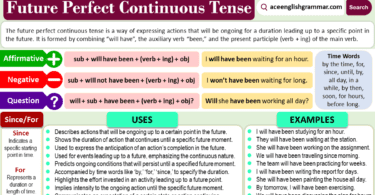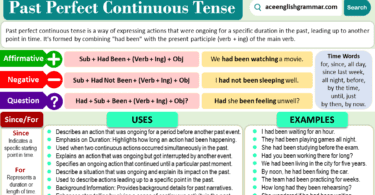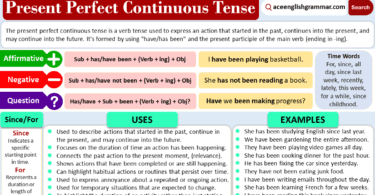The Present Continuous Tense is used to describe actions that are happening right now or are in progress at the moment of speaking. It is formed by using the present tense of the verb “to be” (am, is, are) and the -ing form of the main verb. For instance, “I am studying” or “They are playing football” are examples of this tense, indicating ongoing actions.
Table of Contents
What is Present Continuous Tense?
The Present Continuous Tense (also called Present Progressive Tense) is used to describe an action that is happening right now or around the current moment.
The verb “to be” is used as follows:
- am for “I”
- are for “you, we, they”
- is for “he, she, it”
Example:
- “She is running” — here, “is” is the present form of “to be,” and “running” is the main verb in its -ing form.
Structure of the Present Continuous Tense
Positive Sentences (+)
To form positive sentences, the structure is:
- Subject + am/are/is + present participle (-ing form)
Examples:
- I am reading a book.
- She is studying for her exams.
- They are watching a movie.
These sentences indicate that the actions are happening now or are ongoing.
Negative Sentences (-)
For negative sentences, use “not” after the verb “to be”:
- Subject + am/are/is + not + present participle
Examples:
- I am not working today.
- They are not attending the meeting.
- She is not writing the letter.
These sentences emphasize that the action is not happening at the moment.
Interrogative Sentences (?)
To ask questions, invert the subject and “to be”:
- Am/are/is + subject + present participle?
Examples:
- Are you reading a book?
- Is he studying for the exam?
- Are they coming to the party?
These questions ask whether an action is in progress at the moment.
Time Words in Present Continuous Tense
The Present Continuous often uses time expressions to highlight that the action is happening right now or around the current time. Common time words include:
- Now
- At the moment
- Right now
- Currently
- These days
For instance:
- I am watching TV right now.
- She is working on her project at the moment.
When Do We Use Present Continuous Tense?
1. For actions happening now
- Zaid is studying at the moment.
- They are walking to school.
2. For temporary actions
- Fatima is living in Lahore for a month.
- I am using my brother’s laptop today.
3. For future plans (with time reference)
- We are going to Karachi tomorrow.
- She is meeting Ahmed in the evening.
Rules of Present Continuous Tense
- Formation:
Combine “am,” “is,” or “are” with the present participle (verb + -ing).- He is reading a book.
- Negative Form:
Add “not” after “am,” “is,” or “are.”- I am not studying right now.
- Interrogative Form:
Invert the subject and “am/are/is” to form questions.- Are you going to the party?
- Spelling Rules for -ing Form:
- For verbs ending in “e,” drop the “e” and add -ing: write → writing.
- For one-syllable verbs with a consonant-vowel-consonant pattern, double the final consonant before adding -ing: run → running.
Present Continuous vs Future Continuous Tense
| Aspect | Present Continuous | Future Continuous |
|---|---|---|
| Definition | Action happening right now or around the present. | Action that will be happening at a specific time in the future. |
| Structure | Subject + am/is/are + verb-ing | Subject + will be + verb-ing |
| Example | Ahmad is studying for his test. ✅ | Ahmad will be studying at 9 PM. ✅ |
| Time Reference | Now / current moment | Specific future time |
| Signal Words | now, currently, at the moment | tomorrow, next week, at this time next year |
Examples of Present Continuous Tense
✅ Affirmative
- Ayaan is drawing a mosque.
- I am drinking green tea.
- They are helping their teacher.
- She is wearing a blue hijab.
- We are attending class online.
❌ Negative
- I am not eating anything.
- He is not calling anyone.
- We are not going outside.
- You are not doing your homework.
- Huda is not talking to Bilal.
❓ Interrogative
- Are they praying now?
- Is Hamza reading the Quran?
- Am I doing this correctly?
- Are you listening?
- Is she learning Arabic?
Common Mistakes and Corrections
- He am writing a letter. ❌
- He is writing a letter. ✅
- We is studying English. ❌
- We are studying English. ✅
- Are she coming to class? ❌
- Is she coming to class? ✅
- I am not play football. ❌
- I am not playing football. ✅
- They are eats dinner. ❌
- They are eating dinner. ✅
Practice Exercises of Present Continuous Tense
Fill in the blanks:
- He ______ (write) a letter.
- I ______ (not go) to school today.
- ______ they ______ (watch) a movie?
- Fatima ______ (cook) dinner now.
- We ______ (study) for exams.
Answers:
- is writing
- am not going
- Are, watching
- is cooking
- are studying
FAQs
Subject + am/is/are + verb+ing
For actions happening now, temporary situations, or future plans.
No. Use “am/is/are” instead of “do/does”.
Yes. It’s the correct form for “they/we/you”.
“I eat” shows a habit. “I am eating” means it’s happening now.
Read More





Leave a Comment